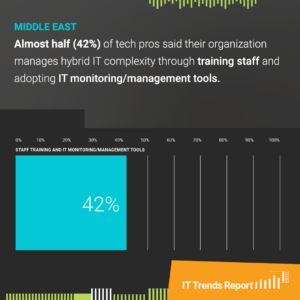SolarWinds has released the findings of its ninth annual IT Trends Report. This year’s report, The SolarWinds IT Trends Report 2022—Getting IT Right: Managing Hybrid IT Complexity, examines the acceleration of digital transformation efforts and its impact on IT departments. The report found the acceleration of hybrid IT has increased network complexity for most organizations and caused several worrisome challenges for IT professionals.
 The new SolarWinds report found tech professionals feel less confident in their organisation’s ability to manage IT. While nearly half (42%) of tech pro respondents state they leverage monitoring strategies to manage this complexity, 58% revealed they lack visibility into the majority of their organisation’s apps and infrastructure. This lack of visibility impacts their ability to conduct anomaly detection, easy root-cause analysis, and other critical processes to ensure the availability, performance, and security of business-critical applications.
The new SolarWinds report found tech professionals feel less confident in their organisation’s ability to manage IT. While nearly half (42%) of tech pro respondents state they leverage monitoring strategies to manage this complexity, 58% revealed they lack visibility into the majority of their organisation’s apps and infrastructure. This lack of visibility impacts their ability to conduct anomaly detection, easy root-cause analysis, and other critical processes to ensure the availability, performance, and security of business-critical applications.
“Operational complexity prevents organisations from capitalising on their technology-driven transformation and investments and delivering benefits for end users,” said Sudhakar Ramakrishna, president and CEO, SolarWinds. “As organisations look beyond the pandemic, they must re-examine their investments from the past few years. Part of that requires organizations to have visibility into their IT environments to understand what’s working and not working, and where to prioritise their efforts to achieve the ROI targeted in their planned projects.”
“Observability is increasingly becoming the clear answer for tech pros charged with managing greater levels of complexity in these diverse and distributed environments spanning on-premises, private and public clouds,” added Ramakrishna. “However, organisations must set aside time and resources to upskill and train tech pros to help them properly implement observability strategies and manage hybrid IT realities more effectively—and set up their teams and business for success in the long run.”
2022 Key Findings
The continued expansion to hybrid IT is driving increased levels of IT management complexity, but tech pros feel a lack of confidence in how to best manage it.
- One in five (20%) responded the acceleration of hybrid IT has increased the complexity of their organization’s IT management.
- These tech pros reported the following top drivers of increased complexity:
- Inefficient change management processes (60%)
- Outdated staff skillsets no longer aligned with new technologies (40%)
- Increased technology requirements from multiple departments (40%)
- New tools and/or technologies (35%)
- Interestingly, 50% of small businesses indicated outdated staff skillsets no longer aligned with new technologies as the leading cause for increased complexity, compared to 22% of their mid-size and 57% of their enterprise counterparts.
A particular area of concern among respondents is visibility. With the increased shift to complex, hybrid IT environments, technology professionals say they have limited visibility into their networks, apps, and infrastructure.
- When asked about current IT monitoring/management strategies, 58% of respondents stated they only have visibility into about half or less of their apps and infrastructure.
- By business size, 36% of mid-sized businesses and 37% of enterprise tech pro respondents indicated their organisation provides visibility into most of their apps and infrastructure compared to only 18% of their small business counterparts.
- Easy root cause analysis (55%), the ability to gather metrics from disparate systems (48%), and anomaly detection (45%) were revealed as the top three aspects lacking from respondents who felt their current IT monitoring/management strategies provide visibility into less than half of their apps and infrastructure strategy.
Organisations’ lack of insight into their networks impacts ROI.
- Most respondents (84%) agreed return on investment (ROI) was impacted during an IT project they oversaw in the past 12–18 months due to increased hybrid IT complexity.
- Thirty-five percent of respondents said the IT project in question took an additional four to seven months or more to complete
- Forty-seven percent said the project in question was extended by up to three months
- By business size, a smaller percentage of small business tech pro respondents (14%) indicated a shorter delay of one to four weeks to achieve expected ROI when compared to their mid-size (15%) and enterprise counterparts (29%).
Overcoming IT complexity obstacles and improving ROI will be difficult, with budget and time constraints looming.
- Respondents say the largest barriers to improving visibility and implementing observability as an IT strategy are:
- Outdated technology environments (42%)
- Time constraints (33%)
- Lack of resources (33%)
- Lack of budget (30%)
- Interestingly, as business size decreases, the percentage of tech respondents who viewed lack of budget as a barrier increases.
- 41% of small business tech pros report budget as a barrier, as compared to 31% and 24% for their mid-size and enterprise counterparts.
There is a planned lack of investment despite the fact almost half of respondents (42%) said the best solution to manage increased complexity is to adopt IT management tools.
- Sixty-four percent of tech pro respondents state their organization has prioritized adopting a hybrid IT strategy for their technology environment within the next three years.
- The biggest areas of impact respondents expect to see if their organizations implemented these IT management tools would be:
- Heightened performance of apps (33%)
- Converged roles/responsibilities which drive budget savings (31%)
- Increased productivity (29%)
- Other strategies respondents mentioned as important to help to meet complexity issues include:
- Investing in automation tools (43%)
- Adopting IT monitoring and/or management tools (42%)
- Training staff and upskilling (42%)
Please visit the SolarWinds IT Trends Index, a dynamic web experience exploring the study’s findings and additional insights into the data broken down by region into charts, graphs, and socially shareable elements. Like previous IT Trends Reports, this year’s study features an interactive component where visitors to the web experience can see how they compare to the results.
The findings of this year’s Middle East report are based on a survey fielded in March 2022, which yielded responses from 102 technology practitioners, managers, directors, and senior executives in the Middle East from public- and private-sector small, mid-size, and enterprise organizations. All regions studied in 2022, as reported on the SolarWinds IT Trends Index, were North America, Australia, France, Germany, Japan, Singapore, the Middle East, and the United Kingdom, with 1,138 respondents across all geographies combined.










Discussion about this post